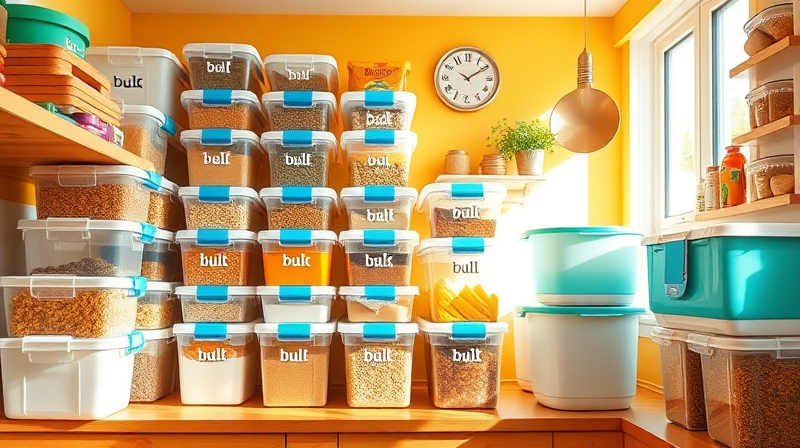Bulk buying is more than just a shopping trend—it's a powerful financial strategy that can help you save money and reduce waste when done correctly. In today's economic climate, savvy shoppers are increasingly turning to bulk purchases to cut costs while maximizing efficiency. However, this approach requires careful planning and a deep understanding of your household consumption patterns. This article highlights both the potential benefits and pitfalls of bulk buying, offering actionable tips to make your bulk purchases truly cost-effective.
Bulk purchasing holds the promise of significant savings. Recent studies from reputable sources point out that buying in bulk can slash the per-unit cost of everyday items. For example, data from LendingTree indicate an average savings of 27% on 30 common products, compared to just 25% a few years ago. Other resources, including CNET, report that committed bulk shoppers have the potential to save over $1,000 per year, showcasing that the numbers really do add up when practiced correctly.
Understanding the Dynamics of Bulk Savings
Bulk savings work on a simple principle: retailers offer lower prices per unit when you purchase larger quantities. This mechanism helps reduce packaging and handling costs, making it a win-win situation for both the consumer and the supplier. The strategy is straightforward and effective provided that the larger quantities are used before the items expire. It's crucial, therefore, to understand your consumption habits and time your bulk purchases to match your actual needs.
Harnessing the full potential of bulk savings means looking beyond the low price tag at the larger picture. When you invest upfront in buying larger quantities, you are essentially banking on the idea that you will use every bit of what you purchase. This approach, if managed well, not only reduces your overall grocery bill but also minimizes the number of trips to the store, thereby saving time and fuel costs.
However, the strategy is not without its risks. One of the most significant hazards of bulk buying is the probability of product waste, particularly with perishable items. The excitement of a great deal can sometimes lead consumers to buy more than they can realistically consume, rendering the savings null if the products spoil before use.
Indeed, the key to successful bulk buying lies in careful planning and realistic assessment of your household needs. This planning prevents the pitfall of over-purchasing items that may end up being wasted, thus ensuring that every penny spent contributes to real savings.
- Overconsumption risk: Having a larger stock of products may lead you to use more than your usual quantity, particularly with snacks or items that have a tendency to be overindulged.
- Storage challenges: Bulk items often require more storage space, which might lead to additional investments in storage solutions or even modifications at home.
- Upfront financial strain: The necessity to pay a larger sum at once can impact your liquidity, tying up funds that might be needed for other pressing expenses.
For these reasons, it becomes essential to adopt smart strategies when buying in bulk. A thoughtful approach ensures that the benefits truly outweigh the risks.
Strategies for Smart Bulk Buying
When considering bulk purchases, start by asking yourself which items are the best candidates for bulk buying. Generally, products with a long shelf life are the safest bet. Non-perishables like rice, pasta, canned goods, and cleaning supplies are ideal, as they are less likely to expire quickly. This way, you can purchase larger quantities without worrying about them going to waste.
Assessing consumption is another critical factor. Before you commit to bulk buying perishable goods like dairy, produce, or condiments, analyze your household's usage habits. Are these items consumed rapidly enough to justify a bulk purchase? If the answer is no, then it might be wiser to limit your bulk buying to non-perishables or consider sharing the purchase with others.
Sharing bulk purchases with family members, friends, or neighbors is a smart and practical approach. This tactic not only splits the upfront cost but also averts the risk of wastage since each party only uses what they need.
Planning your storage solutions is equally important. Ensure that you have adequate space and the appropriate conditions to store your bulk items properly. For instance, products that require refrigeration or freezing must have designated space; otherwise, the risk of spoilage increases dramatically.
In addition to these practices, you should periodically track your actual savings. Compare unit prices before and after bulk purchases to make sure that the deal genuinely offers a reduced cost per unit. Purchasing items simply because they are available in bulk can sometimes lead to a false sense of savings if the per-unit cost is not, in fact, lower.
The advantages of bulk buying are substantial when you approach it with a clear, calculated strategy. By focusing on items that fit your consumption rate, ensuring proper storage, and sharing surplus with others, you convert bulk buying into a reliable method for reducing monthly expenses while maintaining a sustainable lifestyle.
Ultimately, the goal of bulk buying is to maximize efficiency and savings without incurring hidden costs. When executed thoughtfully, bulk purchases can help streamline your grocery shopping, reduce repeated trips to the store, and even lessen your environmental impact by decreasing packaging waste.
Remember, the secret to success lies in meticulous planning. When you know what you need, how much you need, and the best way to store these items, bulk buying becomes a formidable ally in your quest for financial freedom and resource conservation.
Embrace bulk buying with confidence by transforming it into a structured, well-planned habit. With the insights and strategies discussed, you can enjoy significant savings without falling prey to the common pitfalls of wasted products and overcrowded storage—and that is a truly smart investment for both your wallet and your home.







